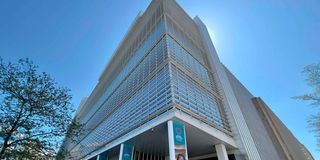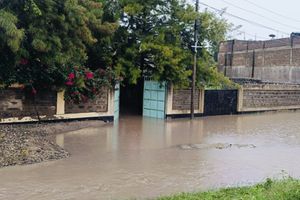World Bank lines up Sh240 billion in new funding to Kenya

The World Bank Group headquarters building in Washington, DC, on April 9, 2023. The international lender has lined up Sh240 billion in new funding to Kenya between March and April.
What you need to know:
- According to the World Bank, Kenya is now accessing about Sh320.6 billion in concessional financing each year.
- The disbursements from World Bank is expected to complement recent debt inflows from peer lenders including the IMF and the Trade and Development Bank.
The World Bank has lined up Sh240.4 billion ($1.5 billion) in new funding to Kenya before the end of the current financial year.
This was revealed by the Central Bank of Kenya (CBK) Governor Kamau Thugge yesterday. He said the cash is marked for disbursement between March and April.
The new funding represents extended support from the multilateral lender, which has traditionally disbursed between Sh120.2 billion ($750 million) and Sh160.3 billion ($1 billion) a year via its Development Policy Operations (DPO) facility in recent years.
The new funding is expected to ease jitters on Kenya’s ability to meet the maturity of its debut Sh320.6 billion ($2 billion) Eurobond in June by ensuring the availability of hard currency.
Disbursements from the facility are expected to complement recent debt inflows from peer lenders including the International Monetary Fund (IMF) and the Trade and Development Bank (TDB).
Exchange rate
Besides potentially offsetting the upcoming Eurobond maturity, the hard currency inflows from the disbursement are expected to prop up the country’s foreign currency reserves, which is in turn expected to contribute to exchange rate stability.
In November last year, the World Bank signalled the availability of additional budget and project financing to Kenya, outlining its commitment over the next three years.
The World Bank has been a key partner for Kenya and the largest provider of development finance.
The lender noted its commitment to supporting Kenya’s growth into becoming an upper-middle-income country over the medium term.
“Over the next three fiscal years, IDA (International Development Association)and IBRD (International Bank for Reconstruction and Development) expects to provide an estimated $4.5 billion, including fast-disbursing operations. Subject to the World Bank executive directors’ approval of new operations, and to factors which affect the banks’ lending capacity, this implies a total financing package of Sh1.9 trillion ($12 billion) over the next three years,” the World Bank noted on November 20.
The IBRD is an arm of the World Bank that lends to governments of middle-income and creditworthy low-income countries while the IDA provides interest-free loans —called credits — and grants to governments of the poorest countries.
Concessional financing
About $3 billion (Sh480.9 billion) will come from the IDA while the balance of $1.5 billion (Sh240.4 billion) is expected to come from the IBRD.
According to the World Bank, Kenya is now accessing about Sh320.6 billion ($2 billion) in concessional financing each year. Combined IDA and IBRD commitments stand at Sh1.3 trillion ($8.3 billion), with Sh705.4 billion ($4.4 billion) available to disburse.
World Bank’s private sector financing arm, the International Finance Corporation, has an investment portfolio of Sh192.3 billion ($1.2 billion) while the Multilateral Investment Guarantee Agency is engaged in Sh67.9 billion ($424 million) in guarantees covering energy, transport, financial, fintech, and tourism sectors.
Kenya could as well have another stab at accessing the international capital markets to issue the first Eurobond in over two years to plug financing gaps, including settling the Eurobond maturity.
“There have been some countries in Africa (Coté D’Ivoire and Benin) who have gotten access to the international capital markets and there is no reason why Kenya cannot access international capital markets and have engaged our lead managers to tell us when market conditions are appropriate for us,” Dr Thugge added.





